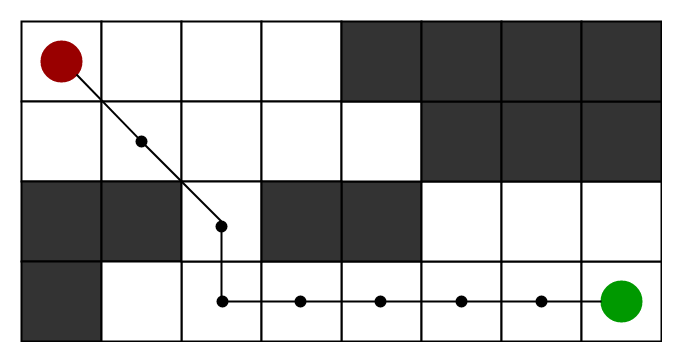
We won't work through all of these, but let's take “Marylebone” as an interesting example. John's Wood”, “Great Portland Street”, Regent's Park”, or “Bond Street”. From here, our next stops can be either “Marylebone”, “St. Our second iteration will then start from “Baker Street”, since this has the lowest estimated total score. This means that after this iteration our open set consists of two entries – “Edgware Road”, with an estimated total score of 1.8687 km, and “Baker Street”, with an estimated total score of 1.4906 km. However, “Edgware Road” is in the wrong direction, so our heuristic from here to the destination gives a score of 1.4284 km, whereas “Baker Street” has a heuristic score of 1.0753 km. Our next stops can be either “Edgware Road”, with a cost of 0.4403 km, or “Baker Street”, with a cost of 0.4153 km. That means that this is implicitly the node that we've got the best “estimated total score” for.
#Path finder algorithm java update#
When we do this, we also work out the new score from this node to each new one to see if it's an improvement on what we've got so far, and if it is, then we update what we know about that node.įor example, let's start from “Marylebone” and attempt to find our way to “Bond Street”.Īt the very start, our open set consists only of “Marylebone”.
Add to the open set all of the nodes that we can reach from it. Select the node from our open set that has the lowest estimated total score. The only requirement is that both scores are consistent with each other – that is, they're in the same units.Īt the very start, our open set consists of our start node, and we have no information about any other nodes at all. This estimate does not need to be accurate, but greater accuracy is going to yield better results. The second is a heuristic to give an estimate of the cost from any node to the destination. One is the score to get from one node to the next. We'll also keep track of the current best score, the estimated total score and the current best previous node for each node in the system.Īs part of this, we need to be able to calculate two different scores. The output is typically the set of nodes that will get us from start to end, in the order that we need to go. For example, “Regent's Park” is directly connected to only “Baker Street” and “Oxford Circus”.Īll pathfinding algorithms take as input a collection of all the nodes – stations in our case – and connections between them, and also the desired starting and ending points. Each stop is only connected to a small subset of the other stops. In our case, this is the distance between stations. Every single step has a particular cost. For example, we can go directly from “Earl's Court” to “Monument”, but not to “Angel”. We may or may not have a direct route between our starting and ending points. This has a lot of interesting components to it: (“ London Underground Overground DLR Crossrail map” by sameboat is licensed under CC BY-SA 4.0) 
For this article, we're going to attempt to traverse a portion of the London Underground system:

This graph can be anything at all that needs traversing. A Pathfinding Algorithm is a technique for converting a graph – consisting of nodes and edges – into a route through the graph.






 0 kommentar(er)
0 kommentar(er)
